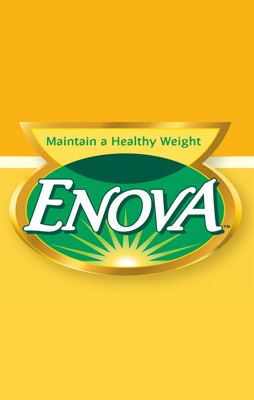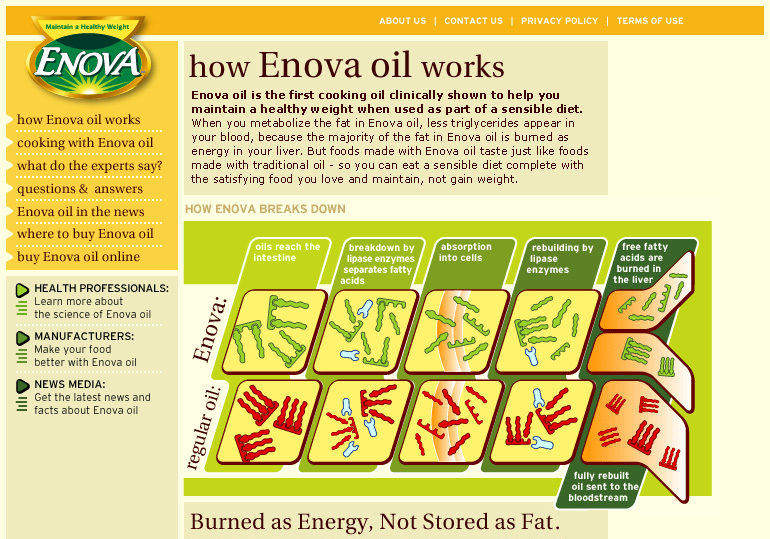Enova Oil Microsite Copy, Infographic Script: getting past the unfamiliar

Don’t change the way you cook
Don’t change the way you eat
Don’t change the way you live
Just change your oil
Enova oil was a 2002 attempt by Kao and ADM to bring a new kind of Japanese cooking oil to the American market. Its virtues were mostly technical – because of its molecular composition, more Enova oil was burned in the liver, it was claimed, instead of being stored by the body as fat. It was a complicated message that had to be couched in a web of legally approved terms and still reach the average consumer. A microsite and an embedded Flash animation about the oil were the online components of a wider campaign by DraftFCB.
Home Page
You want to eat sensibly, but you want your favorite foods prepared the way you like them. Now you can enjoy the foods you love and feel good about it, with Enova oil™. Enova oil is a light-tasting new cooking oil clinically shown to help you maintain a healthy weight as part of a sensible diet, without sacrificing the taste of the foods you love.

How Enova oil Works
Enova oil is the first cooking oil clinically shown to help you maintain a healthy weight when used as part of a sensible diet. When you metabolize the fat in Enova oil, less triglycerides appear in your blood, because the majority of the fat in Enova oil is burned as energy in your liver. But foods made with Enova oil taste just like foods made with traditional oil – so you can eat a sensible diet complete with the satisfying food you love and maintain, not gain weight.

Questions & Answers
If you’re curious about the way this miracle oil worked, and how I broke it down for consumers, you might want to read these FAQs (who doesn’t love a good FAQ?) as I no longer have access to the Flash infographic movie.
Enova Oil: Questions & Answers
What is Enova™ oil?
Enova oil is a new premium cooking oil consisting of high concentrations of diacylglycerol (DAG), a type of fat already found in small quantities in conventional cooking oils. The predominant form of DAG fat in Enova oil is metabolized differently by the body; instead of being stored as fat, the majority of DAG fat is immediately burned as energy.
How does Enova oil work?
Your body is optimized to store the most common fats we eat, like the fats that make up most conventional cooking oils. When food was scarce, storing fat was important, but these days, it’s a problem. Your body isn’t optimized to store the predominant fat in Enova oil because the fat molecules are a slightly different shape than the fat molecules in conventional oil. Your body stores less of the fat from Enova oil and can immediately burn the rest as energy.
How is it different from soy and canola oil? Could I make Enova oil myself from soy and canola?
Enova oil comes from soy and canola, but its main component, DAG oil, is initially present only in small quantities. Through a patented process, ADM Kao LLC – the joint venture between Archer Daniels Midland Company and Kao Corporation of Japan that brought Enova oil to the United States – converts the triacylglycerol (TAG) oil from natural soy and canola oils into a mixture that is at least 80 percent DAG oil. And, no, it’s not something you could do at home.
Is Enova oil natural or artificial?
The diacylglycerol (DAG) oil in Enova oil is found in all natural vegetable oils at low concentrations. It is not an artificial fat substitute. We process natural soy and canola oils with a biological enzyme to produce as much DAG oil as possible. The result is identical to the DAG oil already found in soy and canola, just present at a higher concentration.
What kind of fat is Enova oil?
The oil in Enova oil consists mostly of DAG polyunsaturated fats.
Is Enova oil higher in calories or fat?
Enova oil has essentially the same calories and fat content as the soy and canola oil from which it is made. But remember – less of the fat in Enova oil will be stored in your body, and more of the calories in Enova oil are available to be burned immediately as energy.
Why is Enova oil burned immediately as energy? How can Enova oil be a fat and not act like a fat?
Your body breaks down the oil in foods into components the intestine can absorb. These components are called fatty acids and glycerides. Then the intestine rebuilds the fatty acids and glycerides into triglyceride fats and combines them with cholesterols into packets that are sent to the bloodstream to be carried to body tissues for storage.
Traditional cooking oils consist mostly of molecules called triacylglycerols, or TAGs. Enova oil consists mostly of diacylglycerols, or DAGs. Your body breaks down DAG and TAG oils exactly the same way and absorbs the resulting molecular pieces into the intestine.
Enova oil consists of 80% DAGs. Seventy percent of these DAGs are the (1,3) form of diacylglycerol. Due to the shape of the (1,3) DAG molecules, enzymes in the intestine cannot recombine the pieces of this fat into fat molecules, so less fat is passed into the bloodstream to be stored in the body. Since about 56% of Enova oil is (1,3) DAG fat, that means the majority of the fats in Enova oil are not stored as fat in the body. Instead, the metabolized pieces of this fat are sent to the liver, where they are oxidized – burned as energy. Conventional vegetable oils cannot claim that.
How does Enova oil taste?
Enova oil tastes just like the oil you’re used to – you’ll never notice the difference. Enova oil’s great, light taste lets the flavors of your food come through.
How do I use Enova oil?
You use Enova oil just like you’d use any other oil. You can fry, bake, grill and sauté just as you normally would as part of a sensible diet.
What do clinical studies show regarding weight loss?
Research in clinical trials in both Japan and the United States has shown that fat mass and weight may be reduced when 10 to 20 grams of Enova oil is substituted for conventional oils in a calorie-controlled diet.
Will Enova oil cause digestive problems like some fat substitutes?
No. Enova oil is not an artificial fat like many fat substitutes. Fat substitutes are designed to pass through the body undigested, which is the source of many problems. Enova oil is fully digested by the human body.
Are there any side effects?
Using Enova oil instead of conventional oil has no known adverse side effects. Enova oil has been sold in Japan (as Healthy Econa™ Cooking Oil) since 1999 and is the leading premium oil brand in that country. So, millions of people have safely been enjoying the oil since its introduction.
Is Enova oil FDA approved?
In Japan, Enova oil (sold as Healthy Econa™ Cooking Oil) enjoys full FOSHU and Dry Dock approval, which are the equivalent of US FDA acknowledgement. The FDA has already acknowledged Enova oil’s GRAS status, meaning “generally recognized as safe,” for use in home cooking oil and vegetable spreads. That means Enova oil can be sold as cooking oil and as an ingredient in salad dressing and mayonnaise. ADM Kao is actively working to expand the range of GRAS acceptance so we can bring Enova oil’s benefits to many more kinds of foods.
Has Enova oil been tested?
Enova oil is the product of over 15 years of research in Japan and the United States. In tests in both countries, use of Enova oil was found to produce less fat in the blood, and in some studies it lead to reduced fat mass in the body, when used as part of a sensible diet program. For more information, visits our Heath Professionals section. But the best tests have been done by millions of Japanese shoppers since 1999. They’ve made Enova oil (sold as Healthy Econa Cooking Oil) the number one premium cooking oil in Japan.
Postscript: Whatever happened to Enova oil?
In short, Kao pulled the Japanese and American versions of Enova oil from store shelves in 2009 because testing showed a possibly carcinogenic trace cooking oil component in the oil at levels over 100 times that of normal oil. 100 times. Also, gross fact: the patented process of making Enova oil involved passing the oil through bioreactors – actually giant containers of sand soaked with specially-bred bacteria. Yum!
